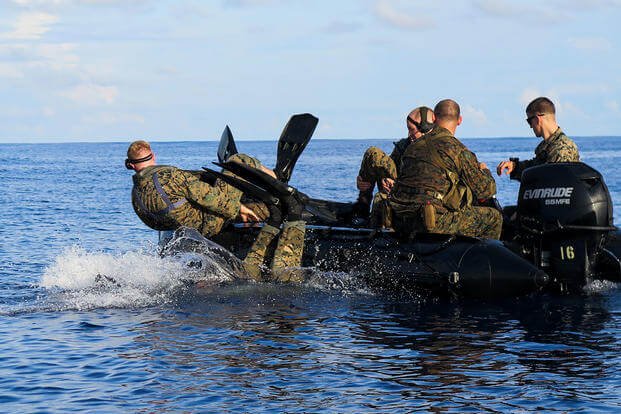If you are considering joining a military diving or any waterborne special-ops program, you will have to swim with fins. Big fins. Swimming with SCUBA fins is more difficult than the snorkeling flippers or swim-team finning workouts.
These fins require time (several weeks) just to get your feet and ankles used to the stress of kicking with a rigid fin. The bigger fins are needed when swimming against currents and carrying extra gear during your swim or dive as well. Here is a great question not only about the actual act of passing treading/swimming tests with fins, but also extra ways to prepare the legs for the strength, endurance and mobility required to perform well without pain.
Stew,
The pipeline I am pursuing (Navy EOD) had a lot of weighted tread evolutions. I have simulated some of these by holding a 25-pound weight to my chest and treading with rocket fins, but have yet to be able to get past 1:15. Obviously, the principle of specificity applies here and I will continue to do these treads, but I was wondering if you had any ideas for exercises to supplement these. Should I be aiming for leg strength, i.e., weighted squats, lunges, etc., or more strength endurance, as in larger numbers of body-weight, lower-body exercise?
Great question. We call the workouts that prepare you for such events Spec Ops Leg Days. But yes, you have to build a base of strength but also muscle stamina as well as ankle and foot mobility.
Try this on your leg days (sample workout):
Warm up with an air-squat pyramid: Run 25 meters, one squat; run 25 meters, two squats; run 25 meters, three squats ... keep going up to 10 squats. We usually do this on a basketball court or field and mix in a series of dynamic stretches for the 25-meter sections like butt kickers, Frankenstein walks, leg swings, side steps, high knees, etc.
Then you do the same squat pyramid but up and down a flight of stairs with a weight vest of about 30 pounds or carrying dumbbells. Go up and down -- one squat. Up and down -- two squats ... until 10. Stretch when needed.
Now the real workout begins:
Repeat 3-5 times
- Five-minute Tabata interval bike at high resistance levels (20 seconds sprint/10 seconds easy)
- Squats 10-15 (weighted)
- Overhead plate carry lunges 10/leg
*You also can run or ruck for five minutes if you prefer for the above interval/leg circuit.
Then you hit the pool and swim with fins for 1,000-1,500 meters.
Now for the tread workout. Tread water with fins as well as without fins to help loosen your legs. Build up over time. Start with a few minutes and build up for 10-15 minutes of treading with no hands with and without fins.
Finally, before you get out of the pool, do dynamic stretches that you did before the workout in chest-deep water.
On another day of the week, a great option for the leg PT/swim drill is the Life Saving/Lunges Workout (video).
Important tips
Hydrate and electrolytes: During the tread, if you are dehydrated, been sweating frequently during the day, did not rehydrate properly and get salts back into your body, you can cramp within a minute of these type of tests. Gatorade, Pedialyte, bananas and other foods with sodium, potassium and calcium will help you with premature cramping.
Mentally prepared: Treading with fins is basically swimming vertically, so be prepared for the gut check mentally. The same type of mental preparation and cardiovascular effort will go into your tread as your swim. Be ready for that.
Floating tips: If you are having a difficult time floating or treading, try to breathe differently when you tread. Keep air fully in your lungs -- hold for 4-5 seconds. Exhale quickly and then quickly inhale again. This will help you float if you are lean by simply keeping the flotation devices in your chest (lungs) full.
Stew Smith is a former Navy SEAL and fitness author certified as a Strength and Conditioning Specialist (CSCS) with the National Strength and Conditioning Association. Visit his Fitness eBook store if you're looking to start a workout program to create a healthy lifestyle. Send your fitness questions to stew@stewsmith.com.
Want to Learn More About Military Life?
Whether you're thinking of joining the military, looking for fitness and basic training tips, or keeping up with military life and benefits, Military.com has you covered. Subscribe to Military.com to have military news, updates and resources delivered directly to your inbox.



















